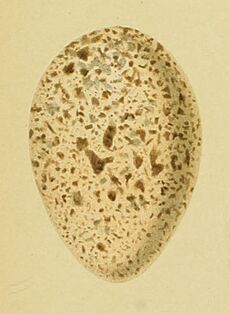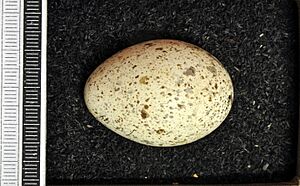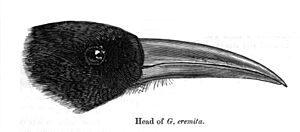Red-billed chough facts for kids
Quick facts for kids Red-billed chough |
|
|---|---|
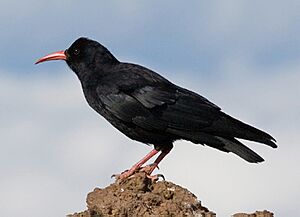 |
|
| Adult of subspecies P. p. barbarus on La Palma, Canary Islands | |
 |
|
| Adult P. p. himalayanus in Sikkim, India |
|
| Conservation status | |
| Scientific classification | |
| Genus: |
Pyrrhocorax
|
| Species: |
pyrrhocorax
|
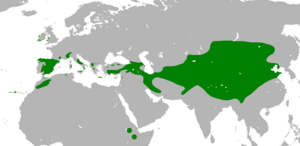 |
|
| Approximate distribution shown in green | |
| Synonyms | |
|
|
The red-billed chough, also known as the Cornish chough, is a special bird. It belongs to the crow family, just like jackdaws and ravens. This bird has shiny black feathers, a long, curved red beak, and red legs. It makes a loud, clear call that sounds like "chee-ow."
Red-billed choughs are amazing flyers. They can perform acrobatic moves in the air! These birds live in many places, from the coasts of Ireland and Britain to the mountains of Europe, North Africa, and even Asia. They often live in mountains or on sea cliffs. They usually build their nests in caves or cracks in cliffs.
Choughs eat mostly small creatures like insects and spiders. They often feed in groups on short grassy areas. Even though they face some dangers, like predators and changes in farming, they are not globally threatened. However, their numbers have dropped in some parts of Europe. The red-billed chough has a long history and is important in some legends, especially in Cornwall.
Contents
Understanding the Red-billed Chough
What's in a Name?
The red-billed chough was first described by a famous scientist named Carl Linnaeus in 1758. Its scientific name is Pyrrhocorax pyrrhocorax. The name Pyrrhocorax comes from Greek words meaning "flame-coloured" and "raven." This refers to its bright red beak and legs.
The word "chough" was originally used for the jackdaw, which is another type of crow. But over time, people started calling this red-billed bird the "chough," especially in Cornwall where it was once very common. There's another bird called the Alpine chough, which is its closest relative. It has a yellow beak instead of a red one.
Different Types of Choughs
There are eight different types, or subspecies, of the red-billed chough around the world. They are all quite similar, but they have small differences in size or feather color. For example, the smallest type lives in the British Isles. A larger type with a longer tail lives in the Himalayas.
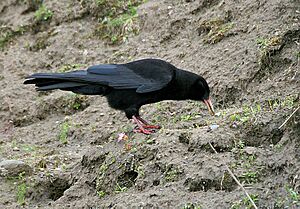
How to Spot a Red-billed Chough
Appearance and Size
An adult red-billed chough is about 39 to 40 centimeters (15 to 16 inches) long. Its wingspan can be up to 90 centimeters (35 inches). It weighs around 310 grams (11 ounces). Its feathers are a shiny, velvet-black, sometimes with a green shimmer. Its most noticeable features are its bright red, curved beak and red legs.
Young choughs look a bit different. Their beaks are orange, and their legs are pink. Their feathers are also less shiny than adult birds.
Telling Choughs Apart
It's easy to tell a red-billed chough from other birds. A jackdaw is smaller and has grey feathers. The Alpine chough, its close relative, has a short yellow beak instead of a red one. Even when flying, you can tell them apart. The red-billed chough has more rectangular wings and a squarer tail.
Their calls are also different. The red-billed chough's "chee-ow" call is louder and clearer than a jackdaw's. It's also very different from the Alpine chough's calls, which sound more like "preep" or "sweeeooo."
Where Red-billed Choughs Live
Habitats Around the World
Red-billed choughs live in many places. You can find them in Ireland, western Great Britain, and southern Europe. They also live in mountains across Central Asia, India, and China. There are even two groups living in the Ethiopian Highlands in Africa. These birds usually stay in the same area all year round; they don't migrate.
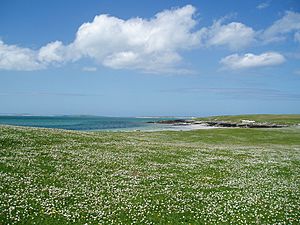
They love high mountains. In North Africa, they live between 2,000 and 2,500 meters (6,500 to 8,200 feet) high. In the Himalayas, they are often found between 2,400 and 3,000 meters (7,900 to 9,800 feet). They have even been seen as high as 7,950 meters (26,000 feet) on Mount Everest! In places like the British Isles, they also live on sea cliffs. They feed on short grass nearby, often in areas called "machair."
Life of a Red-billed Chough
Reproduction and Life Cycle
Red-billed choughs usually start breeding when they are about three years old. They typically have one group of chicks each year. Once a pair finds a mate, they usually stay together for life. They also tend to return to the same nesting spot year after year.
Their nests are big and messy, made of roots and plant stems. They line the nests with soft wool or hair. They build these nests in caves or cracks in cliffs. Sometimes, they even use old buildings or mineshafts. In Tibet, they might nest in monasteries!
A female chough lays three to five eggs. The eggs are about 3.9 by 2.8 centimeters (1.5 by 1.1 inches) and are spotted with brown and grey. The female sits on the eggs for 17 to 18 days to keep them warm. When the chicks hatch, they are tiny and covered in soft down. The male bird brings food to the female while she is on the nest. Both parents then help feed the chicks. The young birds are ready to fly out of the nest after 31 to 41 days.
About 43% of young choughs survive their first year. Adult choughs have a better survival rate, around 80% each year. Choughs usually live for about seven years, but some have lived as long as 17 years!
What Red-billed Choughs Eat
Red-billed choughs mostly eat insects, spiders, and other small creatures without backbones, called invertebrates. Ants are a very important part of their diet. Some choughs in Central Asia even perch on the backs of wild animals to eat parasites! While they mostly eat insects, they will also eat plant material like fallen grains. In the Himalayas, they have been seen eating barley crops. In winter, they often gather in large groups.
They like to feed in short grass, which is often kept short by grazing animals like sheep and rabbits. The number of these animals can affect how well choughs breed. Choughs use their long, curved beaks to pick up ants and beetles from the surface. They also dig into the ground to find grubs and other invertebrates. They usually dig about 2 to 3 centimeters (about 1 inch) deep.
When red-billed choughs live near Alpine choughs, they don't compete much for food. They tend to eat different things. Both types of choughs will sometimes hide food in cracks and cover it with small stones to save it for later.
Natural Dangers
Red-billed choughs have predators like the peregrine falcon, golden eagle, and Eurasian eagle-owl. Ravens might also eat their young chicks. Interestingly, in northern Spain, red-billed choughs like to nest near colonies of lesser kestrels. These small falcons are very good at spotting predators and defending their nests. Choughs nesting near kestrels have a much better chance of their chicks surviving.
Sometimes, a bird called the great spotted cuckoo will lay its eggs in a chough's nest. This is called brood parasitism. Choughs can also get tiny blood parasites, but these usually don't harm them much. They can also carry tiny creatures called mites on their feathers. Some studies suggest these mites might even help the choughs by keeping their feathers clean! Choughs also take care of their feathers by sunbathing and rubbing them with ants, which helps get rid of parasites.
Protecting the Red-billed Chough
Current Status
The red-billed chough lives in a very large area around the world. There are many of them, with an estimated 86,000 to 210,000 birds in Europe alone. Because of their wide range and large numbers, they are currently listed as "least concern" globally. This means they are not in immediate danger of extinction.
However, in Europe, their numbers have gone down and their living areas have become separated. This is mainly because of changes in traditional farming methods. In Europe, the red-billed chough is considered "vulnerable." Only in Spain are they still widespread.
Bringing Them Back
There's good news too! In 2001, a small group of wild red-billed choughs naturally returned to Cornwall, England. This was the first time they had bred there since 1947! Since then, their population has slowly grown in Cornwall.
In Jersey, an island near France, a project started in 2010 to bring the red-billed chough back. The bird had been missing from Jersey since around 1900. The Durrell Wildlife Conservation Trust started a program to breed choughs in captivity. In 2013, they began releasing young choughs onto the north coast of Jersey. This project is helping to restore the chough population in that area.
Choughs in Culture
Ancient Stories
In Greek mythology, the red-billed chough was sometimes called a "sea-crow." It was thought to be special to the god Cronus. It was said to live on a magical island called Ogygia.
Old Beliefs
For a long time, people thought red-billed choughs were linked to fire. Some old stories said they would secretly carry burning sticks and set houses or barns on fire! However, these were just stories. Other old writings that mention "choughs" might actually be talking about jackdaws, not the red-billed chough.
Cornwall's Special Bird
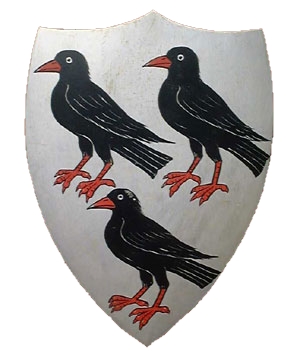
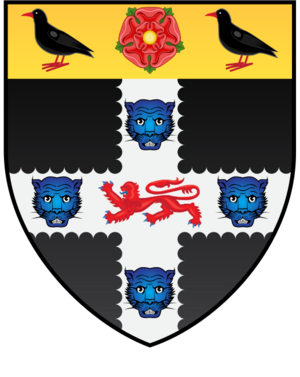
The red-billed chough has a very strong connection to Cornwall, a county in England. It even appears on Cornwall's coat of arms. A famous Cornish legend says that after his last battle, the soul of King Arthur went into a red-billed chough. The red color of the bird's beak and legs is said to come from the blood of that battle. Because of this, killing a chough was considered very bad luck. The legend also says that when the chough returns to Cornwall, King Arthur will return too. This made the choughs' return in 2001 very exciting for many people!
The chough is also linked to Saint Thomas Becket, an important archbishop from the 12th century. His family's coat of arms often shows three Cornish choughs. The reason for this link isn't fully known, but it's a symbol of Becket in many places, including the city of Canterbury.
Choughs on Stamps
The red-billed chough has been featured on postage stamps from several countries. These include Bhutan, The Gambia, Turkmenistan, and Yugoslavia. It is also the animal symbol for the island of La Palma in the Canary Islands.
See also
- List of animal and plant symbols of the Canary Islands
- Operation Chough




